Production of Bio-Oil from Sugarcane Bagasse through Hydrothermal Liquefaction Processes with Modified Zeolite Socony Mobil-5 Catalyst
Abstract
1. Introduction
2. Results and Discussion
2.1. XRD
2.2. FTIR
2.3. SEM-EDS
2.4. TGA
2.5. TEM
3. Materials and Experimental Method
3.1. Materials Used
3.2. Catalyst Preparation
3.3. Production of Bio-Oil
3.3.1. Hydrothermal Liquefaction Process
3.3.2. The Effect of Temperature on the Reaction
3.3.3. The Effect of Residence Time
3.3.4. The Effect of the Ratio of Feedstock to Catalyst
4. Product Analysis: Bio-Oil
4.1. Bio-Oil Yield
4.2. GC-MS
4.3. FTIR
5. Conclusions and Recommendations
5.1. Conclusions
5.2. Recommendations
Author Contributions
Funding
Data Availability Statement
Conflicts of Interest
References
- Musa, S.D.; Zhonghua, T.; Ibrahim, A.O.; Habib, M. China’s energy status: A critical look at fossils and renewable options. Renew. Sustain. Energy Rev. 2018, 81, 2281–2290. [Google Scholar] [CrossRef]
- Jideani, T.; Chukwuchendo, E.; Khotseng, L. An Approach towards the Conversion of Biomass Feedstocks into Biofuel Using a Zeolite Socony Mobil-5-Based Catalysts via the Hydrothermal Liquefaction Process: A Review. Catalysts 2023, 13, 1425. [Google Scholar] [CrossRef]
- Forero, J.A.J.; Tran, T.H.T.; Tana, T.; Baker, A.; Beltramini, J.; Doherty, W.O.S.; Moghaddam, L. Hydrothermal liquefaction of sugarcane bagasse to bio-oils: Effect of liquefaction solvents on bio-oil stability. Fuel 2022, 312, 122793. [Google Scholar] [CrossRef]
- Koçar, G.; Civaş, N. An overview of biofuels from energy crops: Current status and future prospects. Renew. Sustain. Energy Rev. 2013, 28, 900–916. [Google Scholar] [CrossRef]
- Ravichandran, S.R.; Venkatachalam, C.D.; Sengottian, M.; Sekar, S.; Kandasamy, S.; Ramasamy Subramanian, K.P.; Purushothaman, K.; Lavanya Chandrasekaran, A.; Narayanan, M. A review on hydrothermal liquefaction of algal biomass on process parameters, purification and applications. Fuel 2022, 313, 122679. [Google Scholar] [CrossRef]
- Purnama, I.; Trisunaryanti, W.; Wijaya, K.; Mutamima, A.; Oh, W.C.; Boukherroub, R.; Aziz, M. Multi-Pathways for Sustainable Fuel Production from Biomass Using Zirconium-Based Catalysts: A Comprehensive Review. Energy Technol. 2024, 12, 2300901. [Google Scholar] [CrossRef]
- Nishu; Liu, R.; Rahman, M.M.; Sarker, M.; Chai, M.; Li, C.; Cai, J. A review on the catalytic pyrolysis of biomass for the bio-oil production with ZSM-5: Focus on structure. Fuel Process. Technol. 2020, 199, 106301. [Google Scholar] [CrossRef]
- Balasundram, V.; Ibrahim, N.; Kasmani, R.M.; Isha, R.; Hamid, M.K.A.; Hasbullah, H.; Ali, R.R. Catalytic upgrading of sugarcane bagasse pyrolysis vapours over rare earth metal (Ce) loaded HZSM-5: Effect of catalyst to biomass ratio on the organic compounds in pyrolysis oil. Appl. Energy 2018, 220, 787–799. [Google Scholar] [CrossRef]
- Kariim, I.; Swai, H.; Kivevele, T. Bio-Oil Upgrading over ZSM-5 Catalyst: A Review of Catalyst Performance and Deactivation. Int. J. Energy Res. 2023, 2023, 4776962. [Google Scholar] [CrossRef]
- Reza, M.S.; Zhanar Baktybaevna, I.; Afroze, S.; Kuterbekov, K.; Kabyshev, A.; Bekmyrza, K.Z.; Kubenova, M.M.; Bakar, M.S.A.; Azad, A.K.; Roy, H.; et al. Influence of Catalyst on the Yield and Quality of Bio-Oil for the Catalytic Pyrolysis of Biomass: A Comprehensive Review. Energies 2023, 16, 5547. [Google Scholar] [CrossRef]
- Nishu; Li, Y.; Liu, R. Catalytic pyrolysis of lignin over ZSM-5, alkali, and metal modified ZSM-5 at different temperatures to produce hydrocarbons. J. Energy Inst. 2022, 101, 111–121. [Google Scholar] [CrossRef]
- Wei, Y.; Xu, D.; Xu, M.; Zheng, P.; Fan, L.; Leng, L.; Kapusta, K. Hydrothermal liquefaction of municipal sludge and its products applications. Sci. Total Environ. 2024, 908, 168177. [Google Scholar] [CrossRef]
- Unnikrishnan, R.S.G. A novel anionic surfactant as template for the development of hierarchical ZSM-5 zeolite and its catalytic performance. J. Porous Mater. 2020, 27, 691–700. [Google Scholar] [CrossRef]
- Saini, B.; Tathod, A.P.; Diwakar, J.; Arumugam, S.; Viswanadham, N. Corrigendum to “Nickel nano-particles confined in ZSM-5 framework as an efficient catalyst for selective hydrodeoxygenation of lignin-derived monomers” [Biomass Bioenergy 157 (2022) 106350]. Biomass Bioenergy 2023, 177, 106888. [Google Scholar] [CrossRef]
- Sun, L.; Wang, Z.; Chen, L.; Yang, S.; Xie, X.; Gao, M.; Zhao, B.; Si, H.; Li, J.; Hua, D. Catalytic fast pyrolysis of biomass into aromatic hydrocarbons over Mo-modified ZSM-5 catalysts. Catalysts 2020, 10, 51. [Google Scholar] [CrossRef]
- van Vreeswijk, S.H.; Weckhuysen, B.M. Emerging analytical methods to characterize zeolite-based materials. Natl. Sci. Rev. 2022, 9, nwac047. [Google Scholar] [CrossRef]
- Cheng, Y.; Wang, L.-J.; Li, J.-S.; Yang, Y.-C.; Sun, X.-Y. Preparation and characterization of nanosized ZSM-5 zeolites in the absence of organic template. Mater. Lett. 2005, 59, 3427–3430. [Google Scholar] [CrossRef]
- Sarve, D.T.; Singh, S.K.; Ekhe, J.D. Ethanol dehydration to diethyl ether over ZSM-5 and β-Zeolite supported Ni W catalyst. Inorg. Chem. Commun. 2022, 139, 109397. [Google Scholar] [CrossRef]
- Chai, M.; Liu, R.; He, Y. Effects of SiO2/Al2O3 ratio and Fe loading rate of Fe-modified ZSM-5 on selection of aromatics and kinetics of corn stalk catalytic pyrolysis. Fuel Process. Technol. 2020, 206, 106458. [Google Scholar] [CrossRef]
- Daniel, S.; Karel, C.; Monguen, F.; El Kasmi, A.; Arshad, M.F. Oxidative Dehydrogenation of Propane to Olefins Promoted by Zr Modified ZSM-5. Catal. Lett. 2023, 153, 285–299. [Google Scholar] [CrossRef]
- Cui, Y.; Chen, B.; Xu, L.; Chen, M.; Wu, C.; Qiu, J.; Cheng, G.; Wang, N.; Xu, J.; Hu, X. CO2 methanation over the Ni-based catalysts supported on the hollow ZSM-5 zeolites: Effects of the hollow structure and alkaline treatment. Fuel 2023, 334, 126783. [Google Scholar] [CrossRef]
- Nie, P.; Liu, X.; Zhang, P.; Yuan, X.; Li, X.; Lin, S. Quaternary ammonium cellulose promoted synthesis of hollow nano-sized ZSM-5 zeolite as stable catalyst for benzene alkylation with ethanol. J. Mater. Sci. 2021, 56, 8461–8478. [Google Scholar] [CrossRef]
- Anekwe, I.M.S.; Chetty, M.; Khotseng, L.; Kiambi, S.L.; Maharaj, L.; Oboirien, B.; Isa, Y.M. Stability, deactivation and regeneration study of a newly developed HZSM-5 and Ni-doped HZSM-5 zeolite catalysts for ethanol-to-hydrocarbon conversion. Catal. Commun. 2024, 186, 106802. [Google Scholar] [CrossRef]
- Sudarsanam, P.; Peeters, E.; Makshina, E.V.; Parvulescu, V.I.; Sels, B.F. Advances in porous and nanoscale catalysts for viable biomass conversion. Chem. Soc. Rev. 2019, 48, 2366–2421. [Google Scholar] [CrossRef]
- Fu, T.; Chang, J.; Shao, J.; Li, Z. Fabrication of a nano-sized ZSM-5 zeolite with intercrystalline mesopores for conversion of methanol to gasoline. J. Energy Chem. 2017, 26, 139–146. [Google Scholar] [CrossRef]
- Da Silva, L.S.; Araki, C.A.; Marcucci, S.M.P.; da Silva, V.L.D.S.T.; Arroyo, P.A. Desilication of ZSM-5 and ZSM-12 zeolites with different crystal sizes: Effect on acidity and mesoporous initiation. Mater. Res. 2019, 22, 15879–15886. [Google Scholar] [CrossRef]
- Peron, D.V.; Zholobenko, V.L.; de la Rocha, M.R.; Oberson de Souza, M.; Feris, L.A.; Marcilio, N.R.; Ordomsky, V.V.; Khodakov, A.Y. Nickel–zeolite composite catalysts with metal nanoparticles selectively encapsulated in the zeolite micropores. J. Mater. Sci. 2019, 54, 5399–5411. [Google Scholar] [CrossRef]
- Sabarish, R.; Unnikrishnan, G. Synthesis, characterization and evaluations of micro/mesoporous ZSM-5 zeolite using starch as bio template. SN Appl. Sci. 2019, 1, 989. [Google Scholar] [CrossRef]
- Widayat, W.; Annisa, A.N. Synthesis and Characterization of ZSM-5 Catalyst at Different Temperatures. IOP Conf. Ser. Mater. Sci. Eng. 2017, 214, 012032. [Google Scholar] [CrossRef]
- Nagappan, S.; Bhosale, R.R.; Duc, D.; Thuy, N.; Chi, L. Catalytic hydrothermal liquefaction of biomass into bio-oils and other value- added products—A review. Fuel 2021, 285, 119053. [Google Scholar] [CrossRef]
- Makhado, T. Hydrothermal Conversion of Agricultural and Food Waste. 2022. Available online: https://etd.uwc.ac.za/xmlui/bitstream/handle/11394/9087/makhado_m_nsc_2022.pdf?sequence=1&isAllowed=y (accessed on 14 September 2024).
- Deng, W.; Feng, Y.; Fu, J.; Guo, H.; Guo, Y.; Han, B.; Jiang, Z.; Kong, L.; Li, C.; Liu, H.; et al. ScienceDirect Catalytic conversion of lignocellulosic biomass into chemicals and fuels. Green Energy Environ. 2023, 8, 110–114. [Google Scholar] [CrossRef]
- Masfuri, I.; Amrullah, A.; Farobie, O.; Anggoro, T.; Rain, S.F.; Prabowo, W.; Rosyadi, E. Results in Engineering Temperature effects on chemical reactions and product yields in the Co-pyrolysis of wood sawdust and waste tires: An experimental investigation. Results Eng. 2024, 23, 102638. [Google Scholar] [CrossRef]
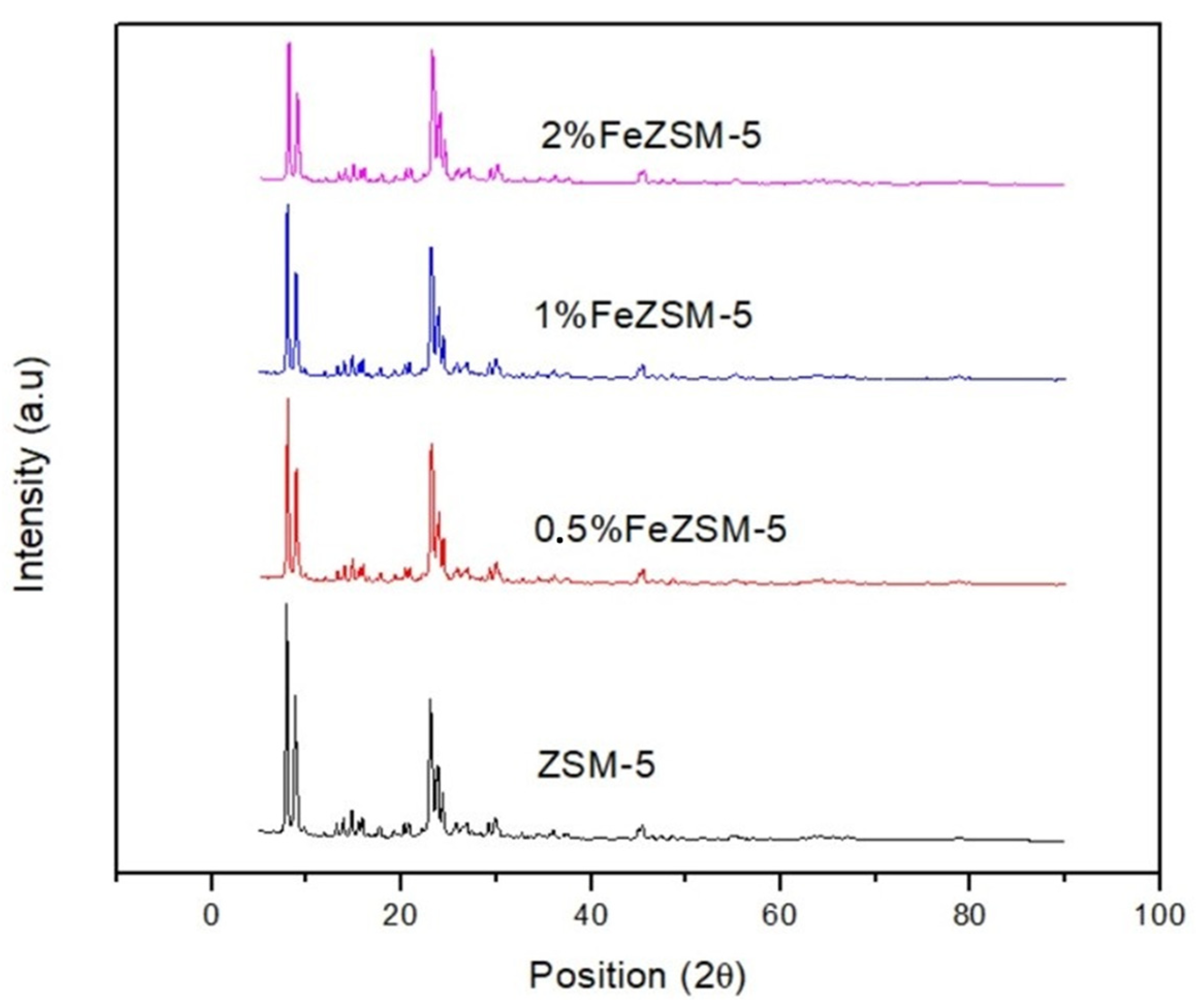

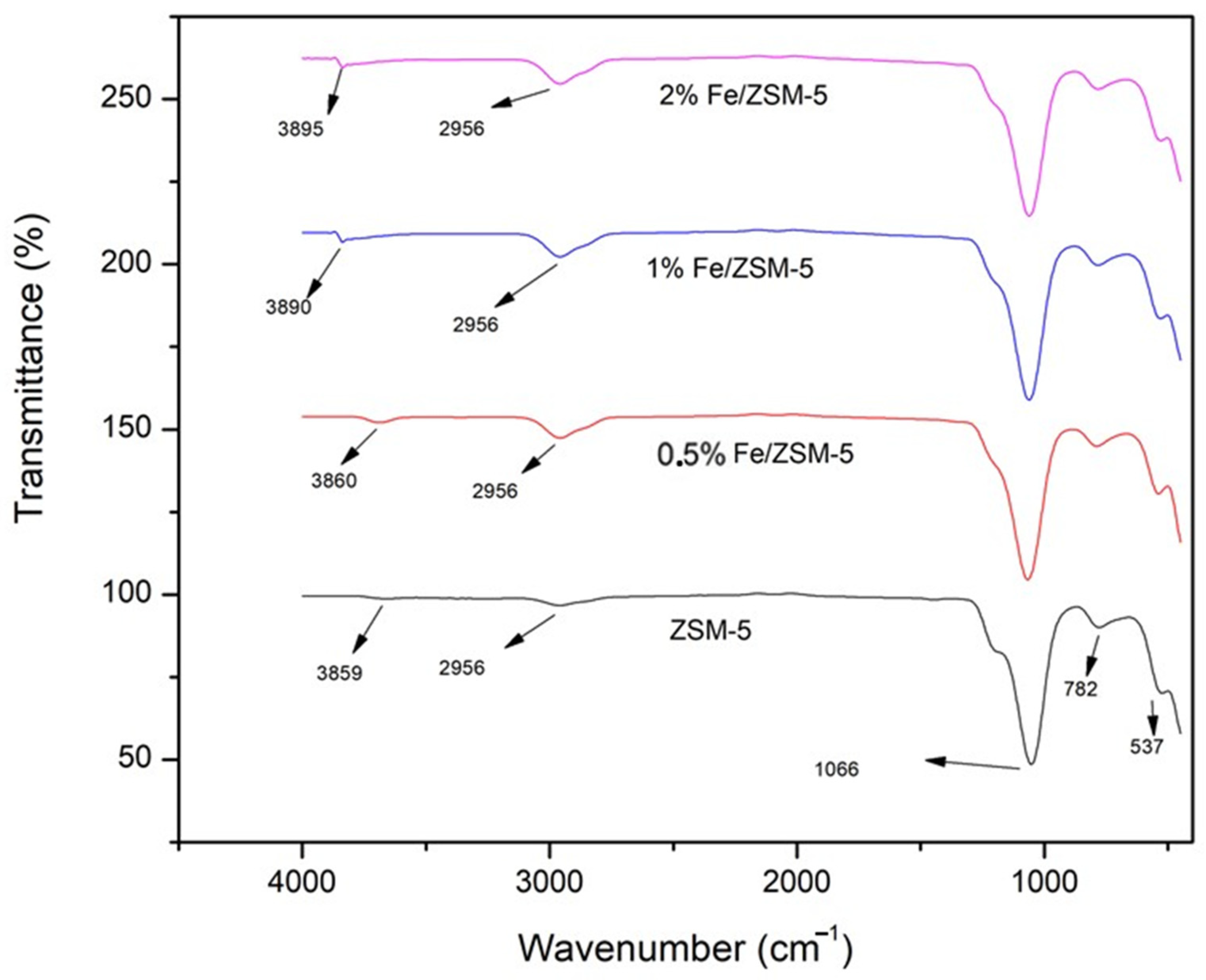
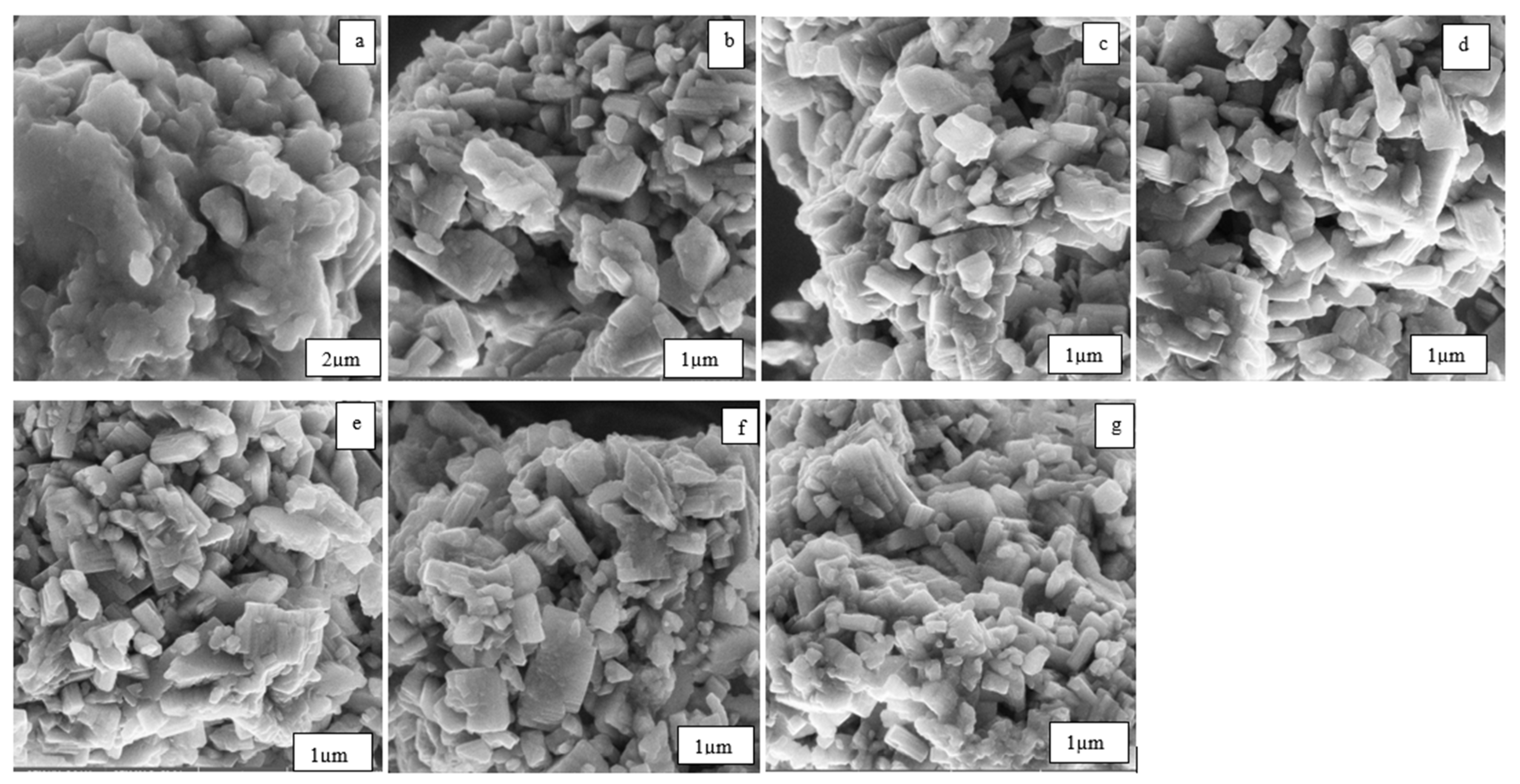
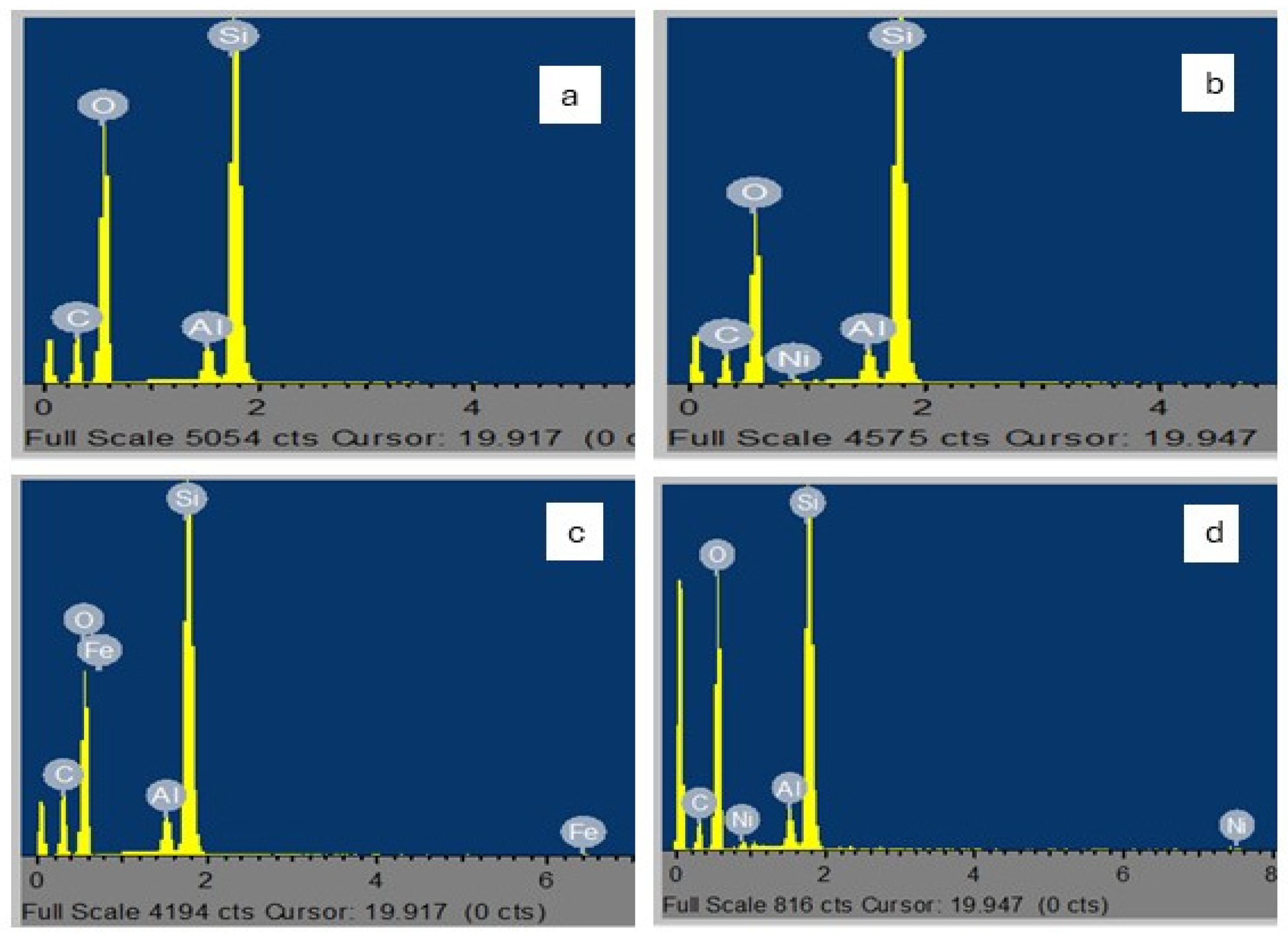
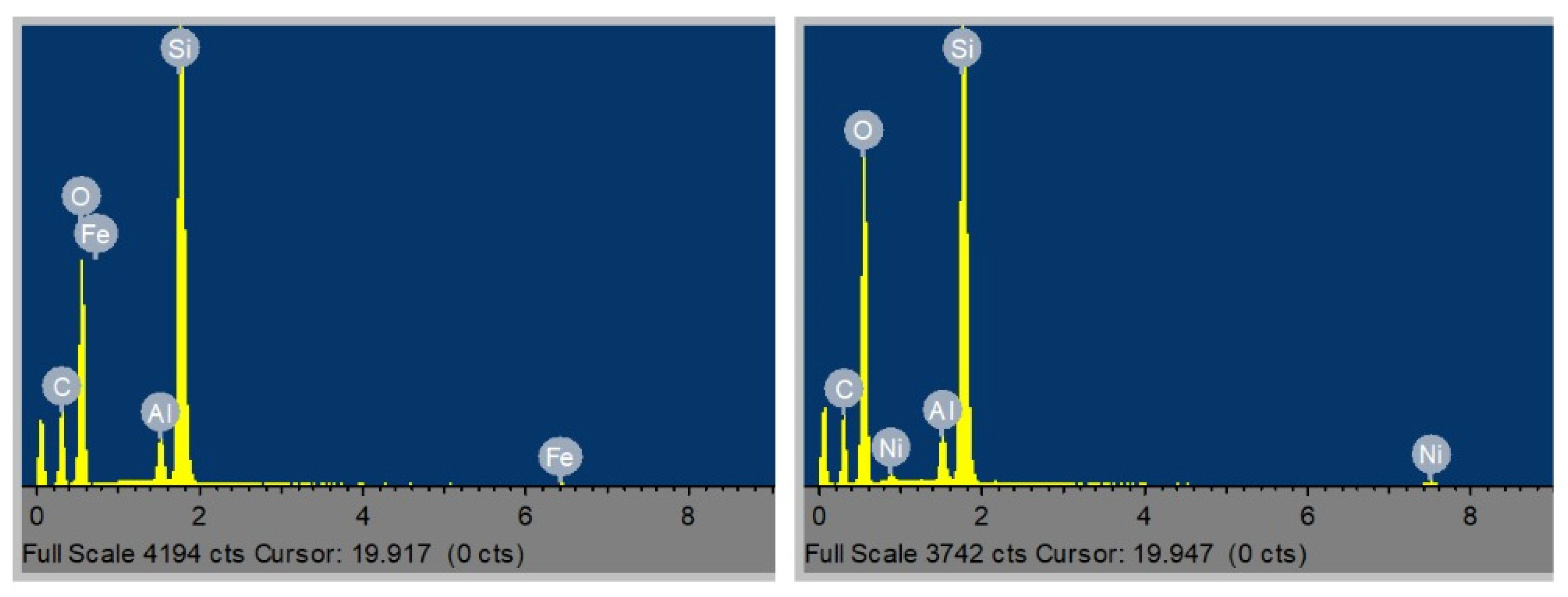
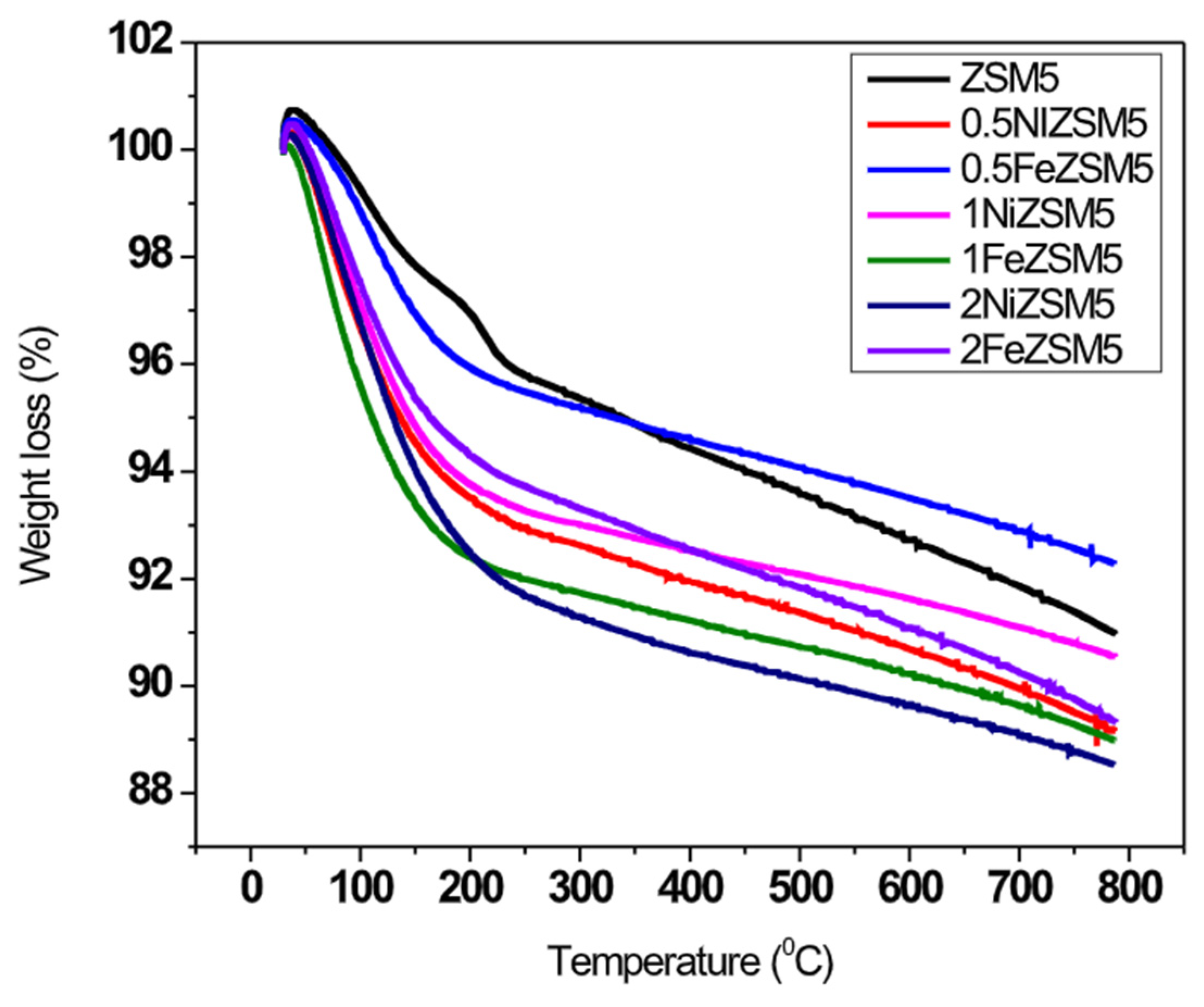
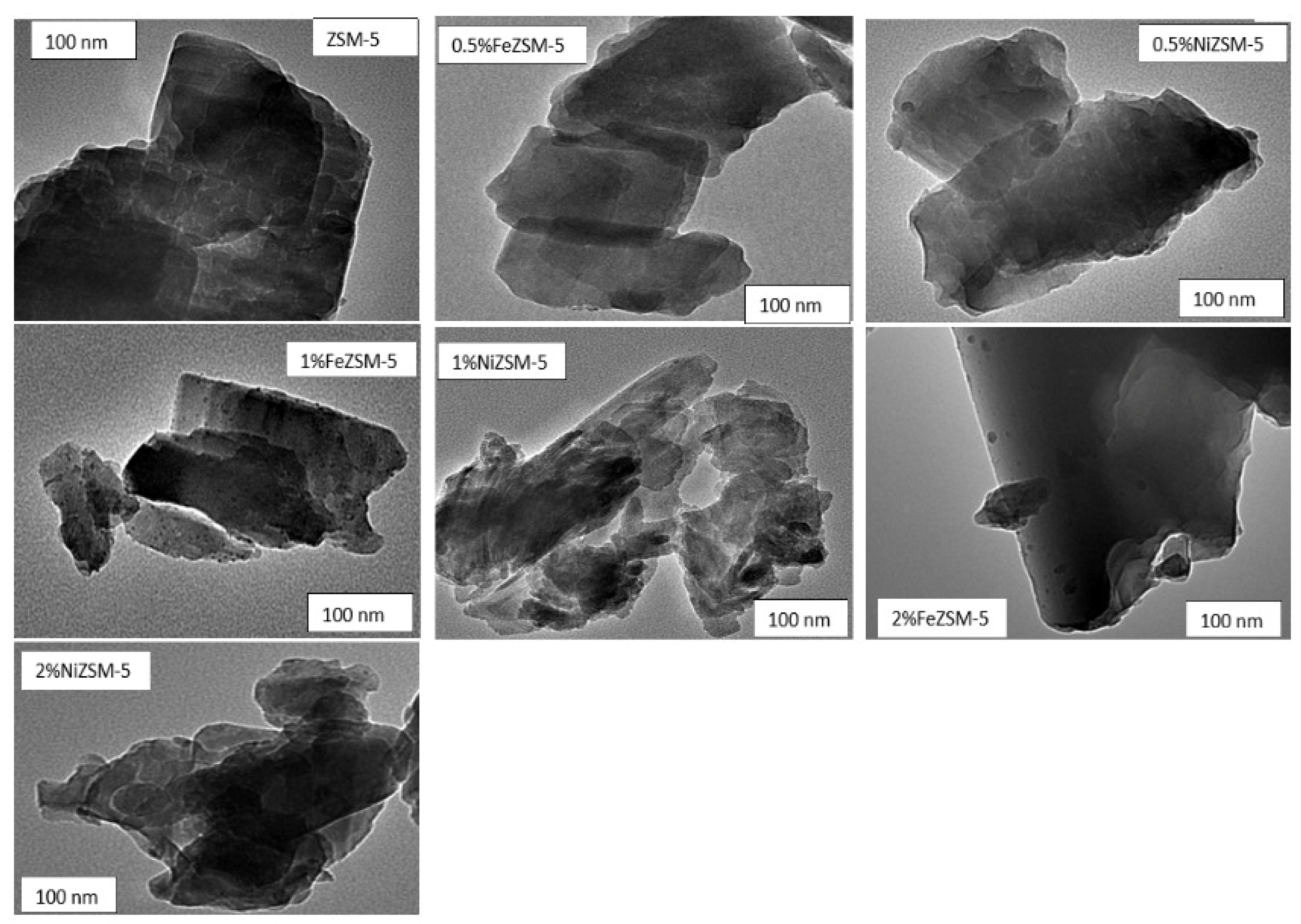

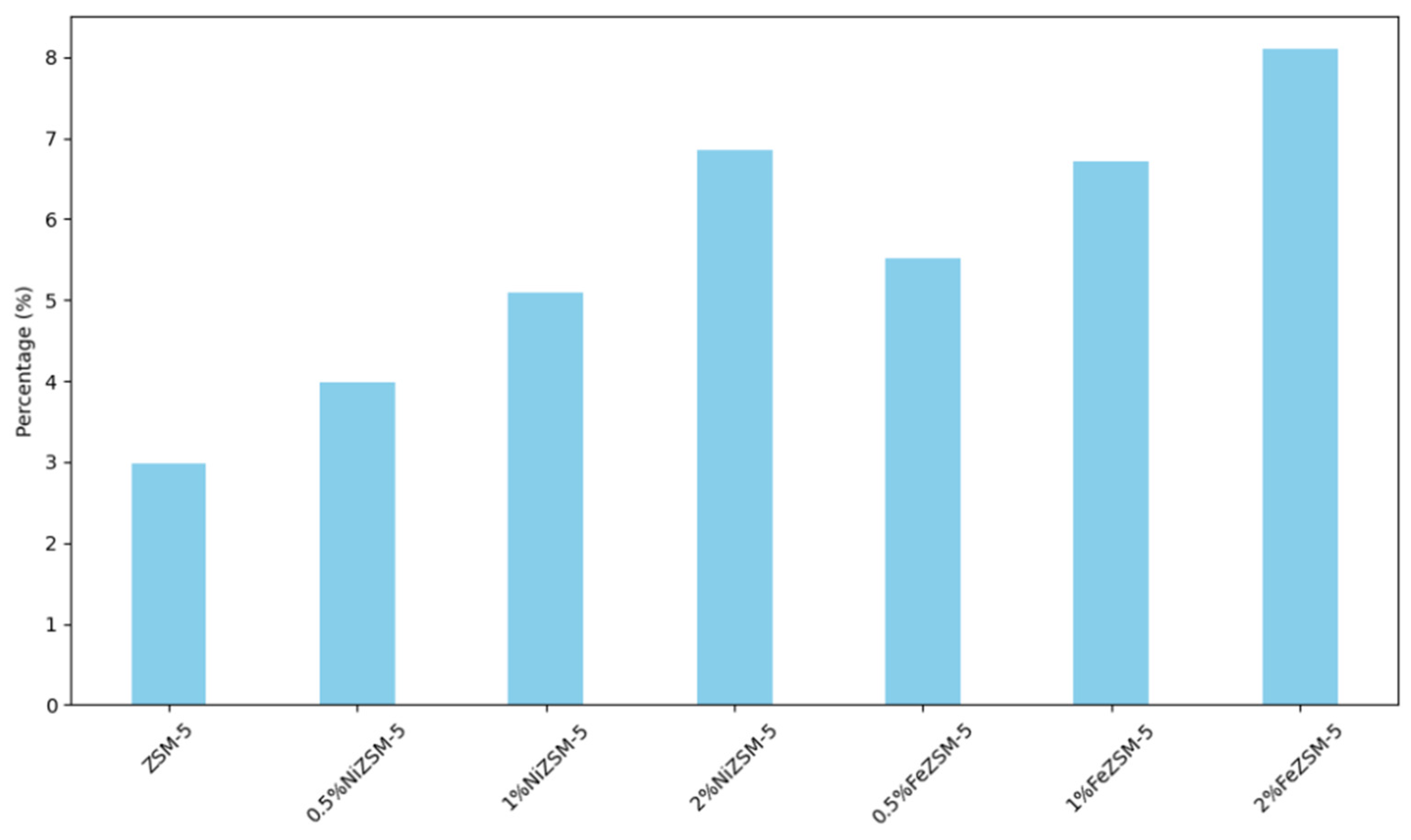
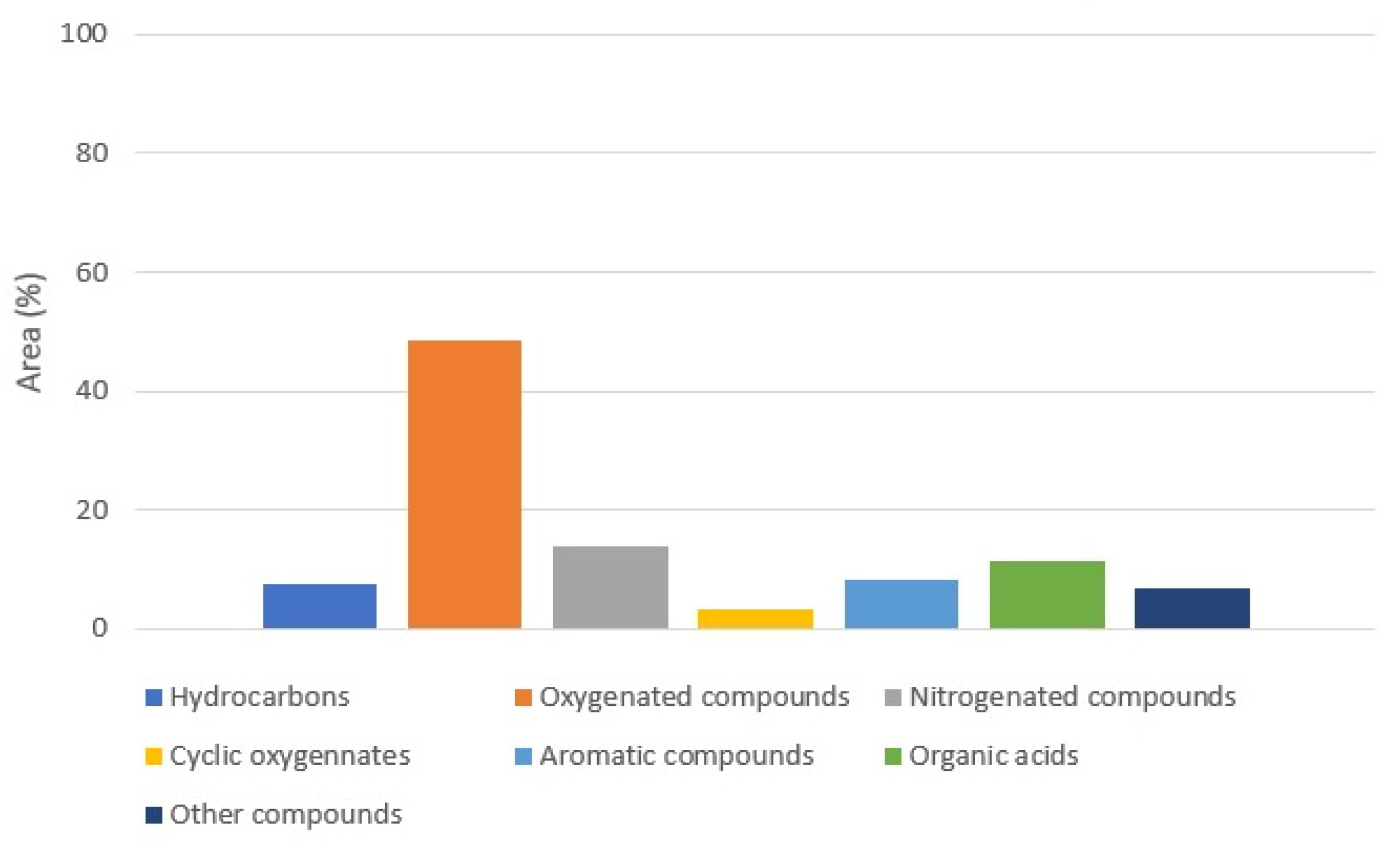


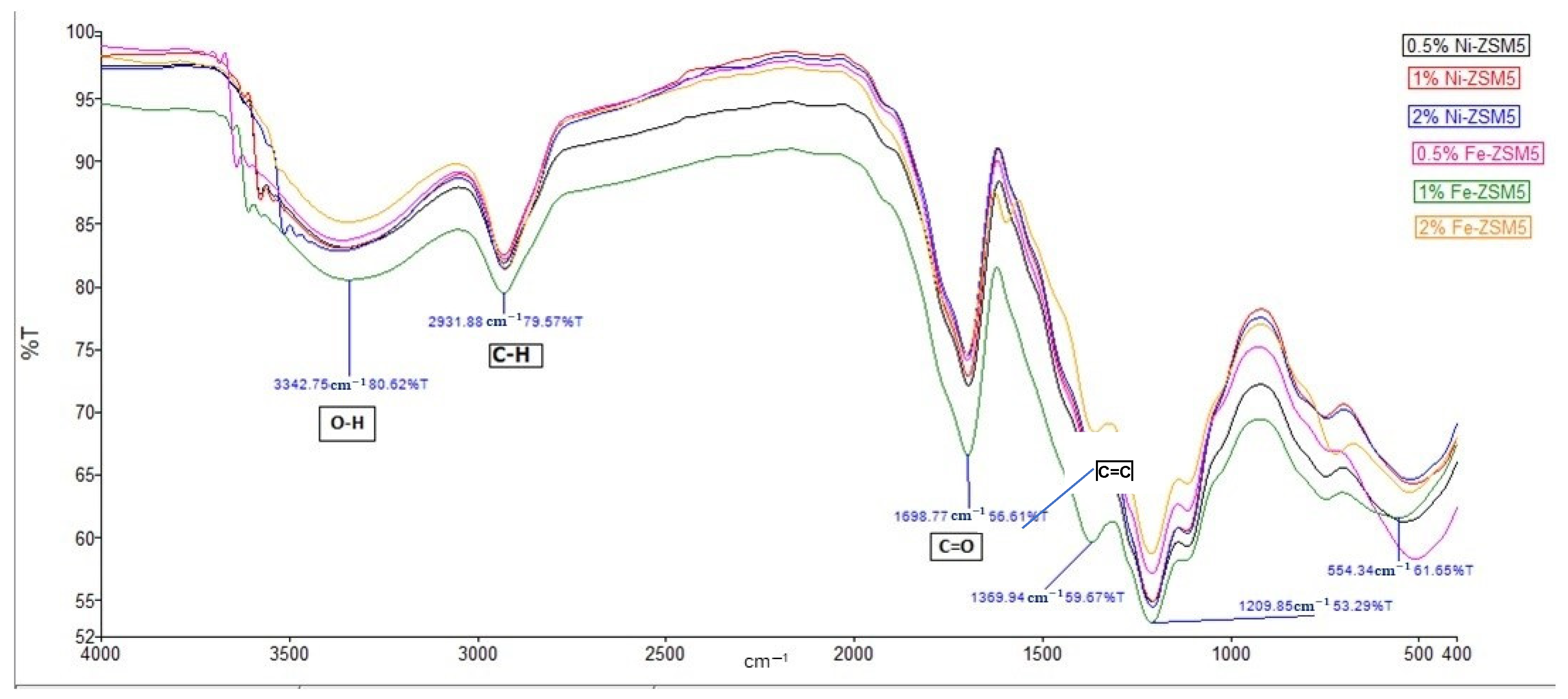
| Catalyst | Elements | |||||
|---|---|---|---|---|---|---|
| C (Atomic %) | O (Atomic%) | Al (Atomic %) | Si (Atomic %) | Fe (Atomic %) | Ni (Atomic%) | |
| ZSM-5 | 31.36 | 47.47 | 1.58 | 19.58 | - | - |
| 0.5% Fe/ZSM-5 | 27.06 | 57.86 | 1.6 | 19.43 | 0.04 | - |
| 0.5% Ni/ZSM-5 | 21.61 | 54.07 | 1.78 | 22.44 | - | 0.11 |
| 1% Fe/ZSM-5 | 35.86 | 47.13 | 1.33 | 15.54 | 0.14 | - |
| 1% Ni/ZSM-5 | 21.62 | 54.59 | 1.84 | 21.58 | - | 0.37 |
| 2% Fe/ZSM-5 | 21.82 | 53.17 | 1.86 | 22.82 | 0.33 | - |
| 2% Ni/ZSM-5 | 23.01 | 53.68 | 1.71 | 20.87 | - | 0.73 |
Disclaimer/Publisher’s Note: The statements, opinions and data contained in all publications are solely those of the individual author(s) and contributor(s) and not of MDPI and/or the editor(s). MDPI and/or the editor(s) disclaim responsibility for any injury to people or property resulting from any ideas, methods, instructions or products referred to in the content. |
© 2024 by the authors. Licensee MDPI, Basel, Switzerland. This article is an open access article distributed under the terms and conditions of the Creative Commons Attribution (CC BY) license (https://creativecommons.org/licenses/by/4.0/).
Share and Cite
Jideani, T.; Seroka, N.S.; Khotseng, L. Production of Bio-Oil from Sugarcane Bagasse through Hydrothermal Liquefaction Processes with Modified Zeolite Socony Mobil-5 Catalyst. Catalysts 2024, 14, 631. https://doi.org/10.3390/catal14090631
Jideani T, Seroka NS, Khotseng L. Production of Bio-Oil from Sugarcane Bagasse through Hydrothermal Liquefaction Processes with Modified Zeolite Socony Mobil-5 Catalyst. Catalysts. 2024; 14(9):631. https://doi.org/10.3390/catal14090631
Chicago/Turabian StyleJideani, Thandiswa, Ntalane Sello Seroka, and Lindiwe Khotseng. 2024. "Production of Bio-Oil from Sugarcane Bagasse through Hydrothermal Liquefaction Processes with Modified Zeolite Socony Mobil-5 Catalyst" Catalysts 14, no. 9: 631. https://doi.org/10.3390/catal14090631
APA StyleJideani, T., Seroka, N. S., & Khotseng, L. (2024). Production of Bio-Oil from Sugarcane Bagasse through Hydrothermal Liquefaction Processes with Modified Zeolite Socony Mobil-5 Catalyst. Catalysts, 14(9), 631. https://doi.org/10.3390/catal14090631









